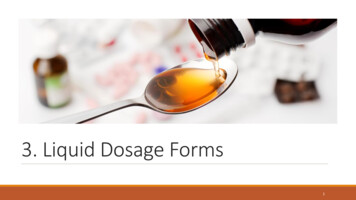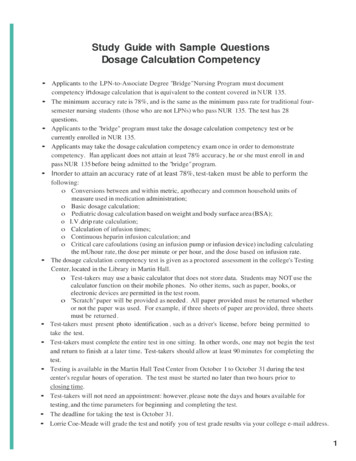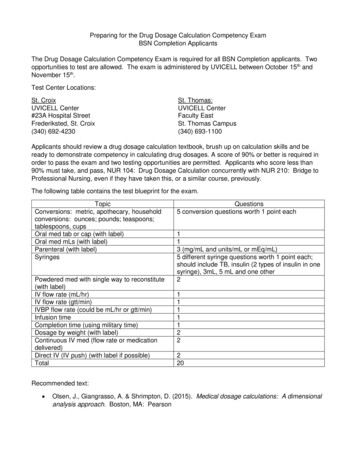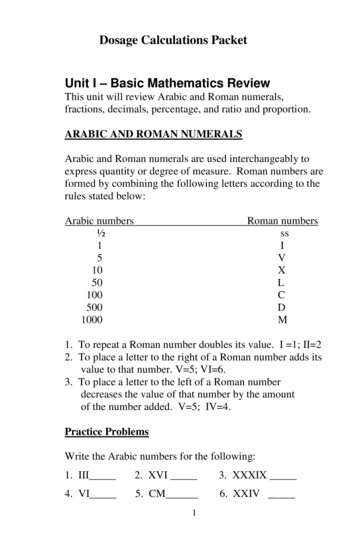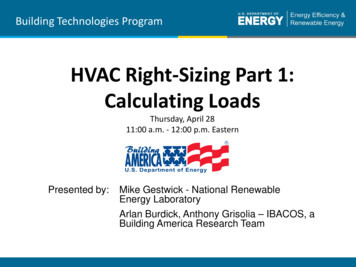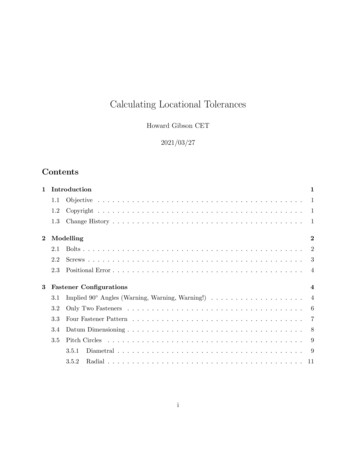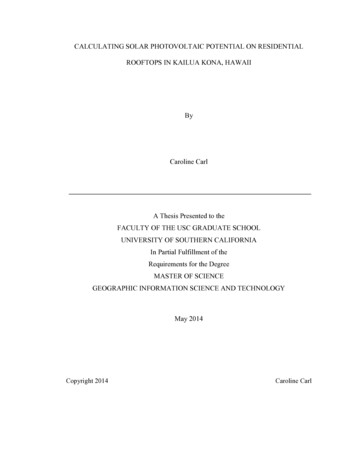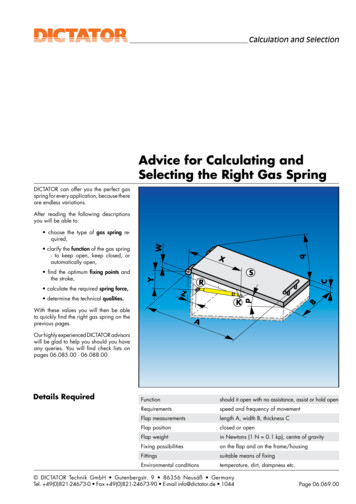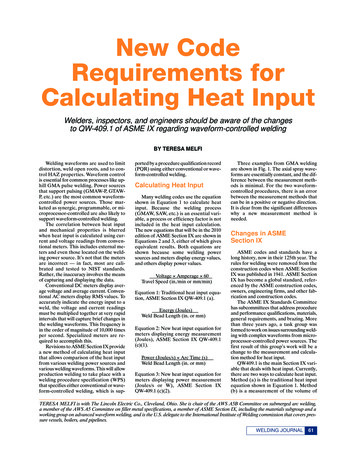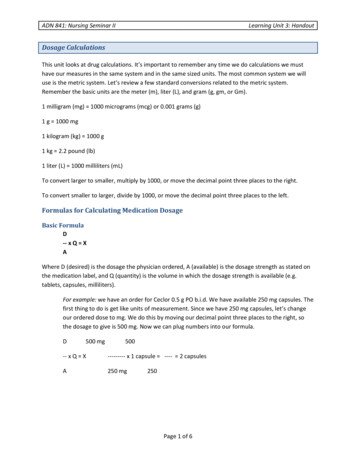
Transcription
ADN 841: Nursing Seminar IILearning Unit 3: HandoutDosage CalculationsThis unit looks at drug calculations. It’s important to remember any time we do calculations we musthave our measures in the same system and in the same sized units. The most common system we willuse is the metric system. Let’s review a few standard conversions related to the metric system.Remember the basic units are the meter (m), liter (L), and gram (g, gm, or Gm).1 milligram (mg) 1000 micrograms (mcg) or 0.001 grams (g)1 g 1000 mg1 kilogram (kg) 1000 g1 kg 2.2 pound (lb)1 liter (L) 1000 milliliters (mL)To convert larger to smaller, multiply by 1000, or move the decimal point three places to the right.To convert smaller to larger, divide by 1000, or move the decimal point three places to the left.Formulas for Calculating Medication DosageBasic FormulaD-- x Q XAWhere D (desired) is the dosage the physician ordered, A (available) is the dosage strength as stated onthe medication label, and Q (quantity) is the volume in which the dosage strength is available (e.g.tablets, capsules, milliliters).For example: we have an order for Ceclor 0.5 g PO b.i.d. We have available 250 mg capsules. Thefirst thing to do is get like units of measurement. Since we have 250 mg capsules, let’s changeour ordered dose to mg. We do this by moving our decimal point three places to the right, sothe dosage to give is 500 mg. Now we can plug numbers into our formula.D500 mg500-- x Q X--------- x 1 capsule ---- 2 capsulesA250 mg250Page 1 of 6
ADN 841: Nursing Seminar IILearning Unit 3: HandoutRatio and ProportionKnown Desired-------- : : ---------H:V D:XWhere the left side represents known quantities, the dose on hand (H), and the vehicle (V), suchas tablets, capsules, milliliters; and the right side represents the desired dose (D) and theunknown amount to be given (X). Multiply the means (V and D), and the extremes (H and X),then solve for X.So, using our previous example where we need to give Ceclor 0.5 g PO b.i.d., and we have 250mg capsules available, we would work it as follows. (We still need to first convert to similarmeasures, so we need to give 500 mg of Ceclor).H :V :: D : X250 mg : 1 capsule :: 500 mg : X capsules1 capsule x 500 mg 250 mg x X500 250X2 XSo, we will give 2 capsules for our dose.Formulas for IV InfusionFlow RateTotal volume in mL x drop factor----------------------------------------- drops per minuteTime in minutesThis will be utilized any time we are using a gravity infusion. Don’t forget the time always needs to be inminutes and the volume always needs to be in mL. Here are a few examples:We need to give 1000 mL of D5W over 24 hours. Our tubing has a drop factor of 20 gtt/mL. Ourtotal volume is in mL, so we don’t have to change it, but our time is in hours. To convert ourtime to minutes, we need to multiply it by 60. So, our total time in minutes will be 1440. Let’splug our numbers into our formula.1000 mL x 20 gtt/mL20,000------------------------- drops/minute -------- 13.89 so we will run our1440 minutes1440infusion at 14 gtt/minPage 2 of 6
ADN 841: Nursing Seminar IILearning Unit 3: HandoutWe need to give 3 L of NS over 24 hours. Out tubing has a drop factor of 15 gtt/ml. Now weneed to change our 3 L to mL by moving our decimal point (3000 mL) and our time to minutes(24 hours 1440 minutes). Plugging this into our formula gives us:3000 mL x 15 gtt/mL 45,000-------------------------- --------- 31.25 gtt/min 31 gtt/min for our rate.1440 minutes1440Flow Rate for Infusion PumpsVolume to be infused in mL---------------------------------- mL per hourTime in hoursWith most infusion pumps we need to program mL per hour. This formula allows us to calculate this.Let’s use the same examples:We need to give 1000 mL of D5W over 24 hours.1000 mL----------- mL/hr 41.6 ml/hr 42 ml/hr for our pump rate24 hoursWe need to give 3L of NS over 24 hours. Here we need to change to mL (3000).3000 ml--------- 125 mL/hr24 hoursComplex CalculationsMany times with IV therapy we have more complex calculations that we have to do. These aresometimes referred to as titrations. We will use some of our basic formulas to do these, but they havemultiple steps that we must go through depending on what we need to administer them.Calculating in units per hour (U/h)200 U of regular insulin has been added to 500 mL of .9% NS. The order states to infuse the regularinsulin IV at 10 U/h. How many mL/h should the IV pump be set at?Now what do we do to figure this out? First we need to know how many units of insulin is in each mL.200 u : 500 mL :: X units : 1 mL 500X 200 X 0.4 units/mLPage 3 of 6
ADN 841: Nursing Seminar IILearning Unit 3: HandoutWe need to run our drip at 10 U per hour, so how many mL contains 10 U?1 mL : 0.4 U :: X mL :10 U 0.4 X 10 X 25 mLWe now know that there are 10 U of insulin in every 25 mL of fluid so we will run our pump at 25 mL perhour.Let’s try another one:20,000 units of heparin has been added to 500 mL of D5W. The order is to infuse the heparin drip at2000 U/h. How many mL/h will we set our pump for?First, let’s find out how many units of heparin are in each mL.20,000 U : 500 mL :: X U : 1 mL 500X 20,000 X 40 units/mLNow, how many mL contain our ordered 2000 U?1 mL : 40 U :: X ml : 2000 U 40 X 2000 X 50 mLSo we will run our pump at 50 mL/h.Calculating by microgram per kilogram per minute (mcg/kg/min)Ordered mcg/kg/min x Patient weight in kg x 60 ------------------------------ mL/hMedication concentration (mcg/1 mL)800 mg of dopamine is added to 250 ml of .9%Ns. The order is to begin the infusion at 3 mcg/kg/minute.The patient’s weight is 70 kg. How many mL/hour will we set the IV pump for?This calculation requires several steps. First, we need to know the concentration of the solution. Wehave 800 mg in 250 mL. Remember we need to have like units, so we need to first change our mg to mcgby moving the decimal point three places to the right. Our solution therefore has 800,000 mcg in 250mL.800,000 mcg : 250 mL :: X mcg : 1 mL 250X 800,000 X 3200 mcg/mLWe will use this number shortly.Our order is for 3 mcg/kg/min. Our patient weighs 70 kg. We need to multiply 70 by 3 to find out thetotal mcg/min. 70 x 3 210, so we will be giving 210 mcg/min.Our pump rate is always mL/hour, so we need to multiply our mcg/min by 60 to get mcg/h.210 x 60 12,600, so we will be giving 12,600 mcg/h.Page 4 of 6
ADN 841: Nursing Seminar IILearning Unit 3: HandoutNow we have to find out how many mL contain our 12,600 mcg. We will use our concentration numberwe got earlier.12,600 mcg : X mL :: 3200 mcg : 1 mL 3200 X 12,600 X 3.9 mLSo, our IV pump rate will be 4 mL/hour.Let’s look at another one:A patient has propofol ordered at 30 mcg/kg/min. The propofol concentration is 15 mg/mL. Thepatient’s weight is 75 kg. How many mL/h should the IV pump be programmed for?First, let’s get our units the same. If we have 15 mg/mL, that means we have 15,000 mcg/mL.Our order is for 30 mcg/kg/min. Our weight is 75 kg, so 75 x 30 2,250, so we will give 2,250 mcg/min.Pumps are always mL/h, so 2250 mcg/min x 60 minutes/h 135,000 mcg/h.We have 15,000 mcg/mL, and need 135,000 mcg/hour so to find our mL/h:1 mL : 15,000 mcg :: X mL : 135,000 mcg 15,000 X 135,000 X 9So, our pump rate will be 9 mL per hour.Calculating microgram per minute (mcg/min)Ordered mcg/min x 60 min/h------------------------------------------ mL/hMedication concentration (mcg/mL)50 mg of nitroglycerin has been added to 500 mL of .9% NS. The order is to infuse the nitroglycerin at 5mcg/min. The nurse needs to calculate how many mL/h the IV pump needs to be set at.First we have to calculate the mcg of the solution. If we have 50 mg in 500 mL, by moving our decimalpoint three spots to the right we have 50,000 mcg in 500 mL.To find the concentration:50,0000 mcg : 500mL :: X mcg : 1 mL500 X 50,000 so X 100 mcg/mLSo, plugging it into our formula gives us5 mcg/min x 60 min/h300--------------------------- X ml/h100 mcg/mL---- X X 3 mL/h100Page 5 of 6
ADN 841: Nursing Seminar IILearning Unit 3: HandoutCalculating milligrams per minute (mg/min)Desired mg/min x 60 min/h----------------------------------------- mL/hMedication concentration (mg/ml)Lidocaine 1 g has been added to 500 mL of D5W. The order states to infuse the lidocaine at 2 mg/min.The nurse needs to calculate the mL/h for the infusion pump.First we need to get like units – 1 g in 500 mL 1000 mg in 500 ml. Now to find the concentration:1000 mg : 500 mL :: X mg : 1 mL 500 X 1000 X 2 mg/mLThen using our formula:2 mg/min x 60 min/h120-------------------------- ----- 60 mL/h2 mg/ml2These are the basic calculations we will need to do for IV therapy. Now I have a practice set of exercisesfor you to complete before you take a quiz over this information. Again, please let me know if you arehaving difficulties with this information. June Cortesio-Stewart and Indian Hills Community CollegePage 6 of 6
ADN 841: Nursing Seminar II Learning Unit 3: Handout Page 1 of 6 Dosage Calculations This unit looks at drug calculations. It’s important to remember any time we do calculations we must have our measures in the same system and in the same sized units.
